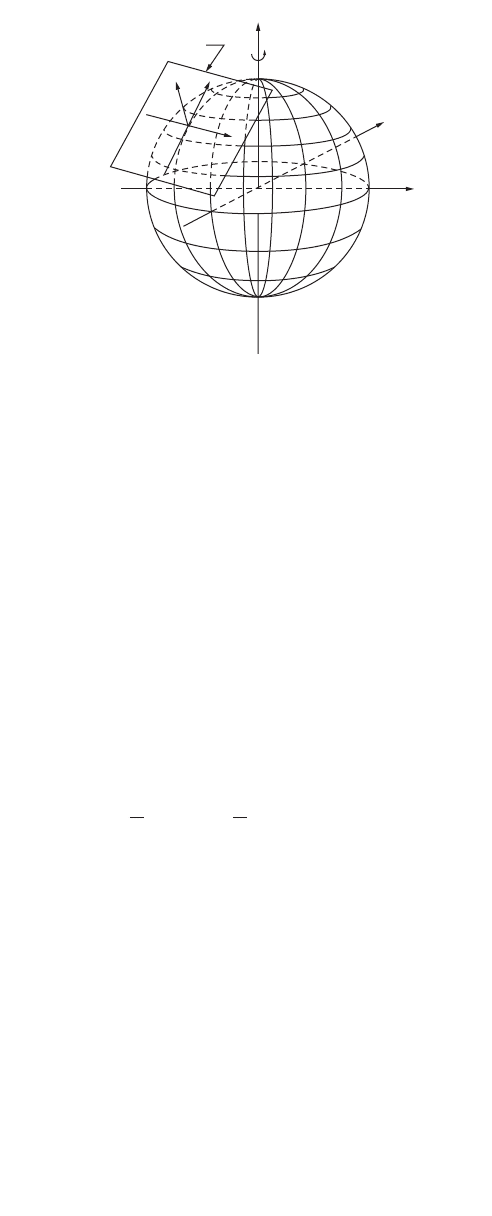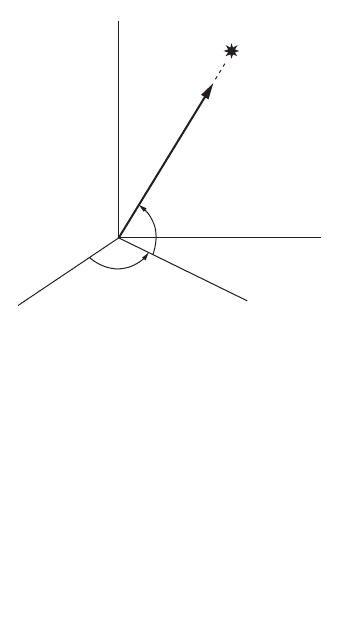Wai-Fah Chen.The Civil Engineering Handbook
Подождите немного. Документ загружается.


55-6 The Civil Engineering Handbook, Second Edition
From Cartesian to ellipsoidal:
(55.13)
The geodetic latitude f can be obtained by the following iteration scheme, starting with an approximate
value for the geodetic latitude f
0
:
(55.14)
If |f – f
0
| > e, then set f
0
equal to f and go back to the computation of N. After the iteration, h can
be computed directly:
(55.15)
Through more cumbersome expressions an analytical solution for the geodetic latitude f as a function
of the Cartesian coordinates {x, y, z} is possible.
Transformations of Same Kind
Orthogonal Transformations: Translation and Rotation
When groups of points are known in their relative position with respect to each other, the use of Cartesian
coordinates (3n in total) becomes superfluous. As a matter of fact there are 6° of freedom, since the
position of the origin with respect to the group is arbitrary, as is the orientation of the frame axes. Two
groups of identical points or, for that matter, one and the same group of points expressed in two arbitrary
but different coordinate frames may be represented by the following orthogonal transformation:
(55.16)
or
(55.17)
The vector t represents a translation. In Eq. (55.16) t¢ represents the vector of the old origin in the
new frame (x¢ - t¢ = Rx); in Eq. (55.17) t represents the coordinates of the origin of the new frame in
the old coordinate frame. The relation between the two translation vectors is represented by
(55.18)
The rotation matrix describes the rotations around the frame axes. In Eq. (55.16) R describes a rotation
around axes through the origin of the x frame; in Eq. (55.17) R describes a rotation around axes through
the origin of the x¢ frame. We define the sense of rotations as follows: the argument angle of the rotation
matrix is taken positive if one views the rotation as counterclockwise from the positive end of the rotation
axis looking back to the origin. For an application relating coordinates in a local frame to coordinates
in a global frame, see Section 55.3.
In the above equations we assume three consecutive rotations, first around the z axis with an argument
angle g, then around the y axis around an argument angle b, and finally around the x axis with the
argument angle a. So we have
(55.19)
l=
()
arctan yx
f
f
ff
0
22
0
22
0
0
2
0
22
1
=+
[]
=-
=+
()
+
[]
arctan
sin
arctan sin
zx y
Na e
zNe x y
hxyzNe N=+++
()
-[ sin ]
22 2
2
f
¢
=+
¢
xRxt
¢
=-
()
xRxt
¢
=-tRt
RR R R=
() () ()
123
abg
© 2003 by CRC Press LLC

Geodesy 55-7
(55.20)
One outcome of these orthogonal transformations is an inventory of variables that are invariant under
these transformations. Without any proof, these include lengths, angles, sizes and shapes of figures, and
volumes — important quantities for the civil or survey engineer.
Similarity Transformations: Translation, Rotation, Scale
In the previous section we saw that the relative location of n points can be described by fewer than 3n
coordinates: 3n – 6 quantities (for instance, an appropriate choice of distances and angles) are necessary
but also sufficient. Exceptions have to be made for so-called critical configurations such as four points
in a plane. The 6 is nothing else than the 6° of freedom supplied by the orthogonal transformation: three
translations and three rotations.
A simple but different reasoning leads to the same result. Imagine a tetrahedron in a three-dimensional
frame. The four corner points are connected by six distances. These are exactly the six necessary but
sufficient quantities to describe the form and shape of the tetrahedron. These six sides determine this
figure completely in size and shape. A fifth point will be positioned by another three distances to any
three of the four previously mentioned points. Consequently, a field of n points (in three-dimensional)
will be necessarily but sufficiently described by 3n – 6 quantities. We need these types of reasoning in
three-dimensional geometric satellite geodesy.
If we just consider the shape of a figure spanned by n points (we are not concerned any more about
the size of the figure), then we need even one quantity fewer than 3n – 6 (i.e., 3n – 7); we are now ignoring
the scale, in addition to the position and orientation of the figure. This constitutes just the addition of
a seventh parameter to the six-parameter orthogonal transformation: the scale parameter s. So we have
(55.21)
or
(55.22)
Here also the vector t represents a translation. In Eq. (55.21) t¢ represents the vector of the old origin
in the new scaled and rotated frame (x¢ – t¢ = sRx); in Eq. (55.22) t represents the coordinates of the
origin of the new frame in the old coordinate frame. The relation between the two translation vectors is
represented by
(55.23)
One outcome of these similarity transformations is an inventory of invariant variables under these
transformations. Without any proof, these include length ratios, angles, shapes of figures, and volume
ratios, which are important quantities for the civil or survey engineer. The reader is referred to Leick and
van Gelder [1975] for other important properties.
Curvilinear Coordinates and Transformations
One usually prefers to express coordinate differences in terms of the curvilinear coordinates on the sphere
or ellipsoid or even locally, rather than in terms of the Cartesian coordinates. This approach also facilitates
the study of effects due to changes in the adopted values for the reference ellipsoid (so-called datum
transformations).
R =
-
-+ +
+-+
Ê
Ë
Á
Á
Á
Á
ˆ
¯
˜
˜
˜
˜
cos cos sin sin
cos sin sin sin cos cos cos sin sin sin sin cos
sin sin cos cos cos sin cos cos sin sin cos cos
bbgb
ag abg ag abg ab
ag abg agabg ab
¢
=+
¢
xRxts
¢
=-
()
xRxts
¢
=-tRts
© 2003 by CRC Press LLC

55-8 The Civil Engineering Handbook, Second Edition
Curvilinear Coordinate Changes in Terms of Cartesian Coordinate Changes
Differentiating the transformation formulas in which the Cartesian coordinates are expressed in terms
of the ellipsoidal coordinates (see Eq. (55.9)), we obtain a differential formula relating the Cartesian total
differentials {dx, dy, dz} as a function of the ellipsoidal total differentials {dl, df, dh}:
(55.24)
The projecting matrix J is nothing else than the Jacobian of partial derivatives:
(55.25)
Carrying out the differentiation, one finds
(55.26)
On inspection, this Jacobian J is simply a product of a rotation matrix R(l, f) and a metric matrix
H(f, h) [Soler, 1976]:
J = RH (55.27)
or, in full,
(55.28)
(55.29)
It turns out that the rotation matrix R(l, f) relates the local {e, n, u} frame to the geocentric {x, y, z}
frame; see further the discussion of earth-fixed coordinates in Section 55.3. The metric matrix H(f, h)
relates the curvilinear coordinates’ longitude, latitude, and height in radians and meters to the curvilinear
coordinates, all expressed in meters.
The formulas just given are the simple expressions relating a small arc distance ds to the corresponding
small angle da through the radius of curvature. The radius of curvature for the longitude component is
equal to the radius of the local parallel circle, which in turn
(55.30)
dx
dy
dz
d
d
dh
Ê
Ë
Á
Á
Á
Á
ˆ
¯
˜
˜
˜
˜
=
Ê
Ë
Á
Á
Á
Á
ˆ
¯
˜
˜
˜
˜
J
l
f
J =
∂
()
∂
()
xyz
h
,,
,,lf
J =
-+
()
-+
()
+
()
-+
()
+
()
È
Î
Í
Í
Í
Í
Í
˘
˚
˙
˙
˙
˙
˙
Nh Mh
Nh Mh
Mh
cos sin sin cos
cos cos
cos cos sin sin
cos sin
cos
sin
fl fl
fl
fl fl
fl
f
f0
R =
--
-
È
Î
Í
Í
Í
Í
˘
˚
˙
˙
˙
˙
sin sin cos cos cos
cos sin sin cos sin
cos sin
lflfl
lflfl
ff0
H =
+
()
+
()
È
Î
Í
Í
Í
Í
Í
˘
˚
˙
˙
˙
˙
˙
Nh
Mh
cosf
00
00
001
d
d
dh
h
d
d
dh
m
m
mm
l
ff
l
f
Ê
Ë
Á
Á
Á
Á
ˆ
¯
˜
˜
˜
˜
=
()
Ê
Ë
Á
Á
Á
Á
ˆ
¯
˜
˜
˜
˜
H ,
rad
rad
© 2003 by CRC Press LLC

Geodesy 55-9
equals the radius of curvature in the prime vertical plane times the cosine of the latitude.
The power of this evaluation is more apparent if one realizes that the inverse Jacobian, expressing the
ellipsoidal total differentials {dl, df, dh} as a function of the Cartesian total differentials {dx, dy, dz}, is
easily obtained, whereas an analytic solution expressing the geodetic ellipsoidal coordinates in terms of
the Cartesian coordinates is extremely difficult to obtain. So, we have
(55.31)
With the relationship in Eq. (55.27) J
–1
becomes simply
(55.32)
or, in full,
(55.33)
This equation gives a simple analytic expression for the inverse Jacobian, whereas the analytic expression
for the original function is virtually impossible.
Curvilinear Coordinate Changes Due to a Similarity Transformation
Differentiating Eq. (55.21) with respect to the similarity transformation parameters a, b, g, t¢
x
, t¢
y
, t¢
z
,
and s, one obtains
(55.34)
with
(55.35)
The Jacobian J
7
is a matrix that consists of seven column vectors
(55.36)
d
d
dh
dx
dy
dz
l
f
Ê
Ë
Á
Á
Á
Á
ˆ
¯
˜
˜
˜
˜
=
Ê
Ë
Á
Á
Á
Á
ˆ
¯
˜
˜
˜
˜
-
J
1
JRHHR
T-
-
-
=
()
=
1
1
1
J
-
=
+
()
+
()
-
+
-
++
È
Î
Í
Í
Í
Í
Í
Í
Í
˘
˚
˙
˙
˙
˙
˙
˙
˙
1
0
sin
cos
cos
cos
sin cos sin sin cos
cos cos cos sin sin
l
f
l
f
fl fl f
fl fl f
Nh Nh
Mh Mh Mh
dx
dy
dz
d
d
d
dt
dt
dt
d
x
y
z
Ê
Ë
Á
Á
Á
Á
ˆ
¯
˜
˜
˜
˜
=
¢
¢
¢
Ê
Ë
Á
Á
Á
Á
Á
Á
Á
Á
Á
Á
Á
Á
ˆ
¯
˜
˜
˜
˜
˜
˜
˜
˜
˜
˜
˜
˜
7
7
J
a
b
g
s
J
7
=
∂
()
∂
¢¢¢
()
xyz
ttt
xyz
,,
,,,,,,abg s
Jjjjjjjj
7 1234567
=
[]
© 2003 by CRC Press LLC

55-10 The Civil Engineering Handbook, Second Edition
with
(55.37)
(55.38)
(55.39)
(55.40)
(55.41)
since
(55.42)
(55.43)
(55.44)
and
(55.45)
(55.46)
(55.47)
The advantage of these L matrices is that in many instances the derivative matrix (product) can be written
as the original matrix pre- or postmultiplied by the corresponding L matrix [Lucas, 1963].
jLRRRx
LRx
Lx
11123
1
1
=
() () ()
=
=
¢
sabg
s
jRLRRx
21223
=
() () ()
sa b g
jRRRLx
RL x
31233
3
=
() () ()
=
sa b g
s
jjj I
456
33
[]
=¥
()
identity matrix
jR R R x
Rx
xt
71 2 3
=
() () ()
=
=
¢
-
¢
()
abg
s
∂∂=
()
=
()
RLRRL
11111
aaa
∂∂=
()
=
()
RLRRL
22222
bbb
∂∂=
()
=
()
RLRRL
33333
ggg
L
1
000
001
010
=
-
Ê
Ë
Á
Á
Á
Á
ˆ
¯
˜
˜
˜
˜
L
2
00 1
00 0
10 0
=
-
Ê
Ë
Á
Á
Á
Á
ˆ
¯
˜
˜
˜
˜
L
3
010
100
000
=-
Ê
Ë
Á
Á
Á
Á
ˆ
¯
˜
˜
˜
˜
© 2003 by CRC Press LLC

Geodesy 55-11
Curvilinear Coordinate Changes Due to a Datum Transformation
Differentiating Eq. (55.9) with respect to the semimajor axis a and the flattening f, one obtains
(55.48)
with (see Soler and van Gelder [1987])
(55.49)
and
(55.50)
Also see Soler and van Gelder [1987] for the second-order derivatives.
Curvilinear Coordinate Changes Due to a Similarity and a Datum Transformation
The curvilinear effects of a redefinition of the coordinate frame due to a similarity transformation and
a datum transformation are computed by adding Eqs. (55.34) and (55.48) and substituting them into
(55.51)
with
(55.52)
55.3 Coordinate Frames Used in Geodesy and Some
Additional Relationships
Earth-Fixed
Earth-Fixed Geocentric
From the moment satellites were used to study geodetic aspects of the earth, one had to deal with modeling
the motion of the satellite (a point mass) around the earth’s center of mass (CoM). The formulation of
the equations of motion is easiest when referred to the CoM. This point became almost naturally the
origin of the coordinate frame in which the earthbound observers were situated. For the orientation of
dx
dy
dz
da
df
af
af
Ê
Ë
Á
Á
Á
Á
ˆ
¯
˜
˜
˜
˜
=
Ê
Ë
Á
ˆ
¯
˜
,
,
J
J
af
xyz
af
,
,,
,
=
∂
()
∂
()
J
af
W
af W
W
af W
eWM Nf
,
cos cos
sin cos cos
cos sin
sin cos sin
sin sin sin
=
-
()
-
()
-
()
-
()
-
()
È
Î
Í
Í
Í
Í
Í
Í
˘
˚
˙
˙
˙
˙
˙
˙
fl
ffl
fl
ffl
ff f
1
1
121
23
23
22
d
d
dh
dx
dy
dz
l
f
Ê
Ë
Á
Á
Á
Á
ˆ
¯
˜
˜
˜
˜
=
Ê
Ë
Á
Á
Á
Á
ˆ
¯
˜
˜
˜
˜
-
J
1
dx
dy
dz
dx
dy
dz
dx
dy
dz
af
Ê
Ë
Á
Á
Á
Á
ˆ
¯
˜
˜
˜
˜
=
Ê
Ë
Á
Á
Á
Á
ˆ
¯
˜
˜
˜
˜
+
Ê
Ë
Á
Á
Á
Á
ˆ
¯
˜
˜
˜
˜
7,
© 2003 by CRC Press LLC

55-12 The Civil Engineering Handbook, Second Edition
the x and z axes, see the discussion of spherical three-dimensional polar coordinates in Section 55.2 and
the discussion of polar motion in this section.
Earth-Fixed Topocentric Cartesian
An often used local frame is the earth-fixed topocentric coordinate frame. The origin resides at the
position of the observer’s instrument. Although in principle arbitrary, one often chooses the x axis
pointing east, the y axis pointing north, and the z axis pointing up. This e, n, u frame is again a right-
handed frame. With respect to the direction of the local z or u axis, various choices are possible: the
u axis coincides with the negative direction of the local gravity vector (the first axis of a leveled theodolite)
or along the normal perpendicular to the surface of the ellipsoid.
An Important Relationship Using an Orthogonal Transformation
The transformation formulas between a geocentric coordinate frame and a local coordinate frame are
(see Fig. 55.4):
(55.53)
One should realize that this transformation formula is of the orthogonal type shown in Eq. (55.16):
(55.54)
whereby x¢ = the geocentric Cartesian vector
R
= R
3
(–l
a
– p/2)R
1
(f
a
– p/2)
t¢
a
= the location of a in the (new) geocentric frame and is equal to:
(55.55)
FIGURE 55.4 A geocentric and a local Cartesian coordinate frame.
x
y
z
u
n
e
Local geodetic
coordinate system
x
y
z
e
n
u
Nh
Nh
Neh
aa
aa a a
aa a a
aaa
Ê
Ë
Á
Á
Á
Á
ˆ
¯
˜
˜
˜
˜
=--
Ê
Ë
Á
ˆ
¯
˜
+-
Ê
Ë
Á
ˆ
¯
˜
Ê
Ë
Á
Á
Á
Á
ˆ
¯
˜
˜
˜
˜
+
+
[]
+
[]
-
()
+
[]
Ê
Ë
Á
Á
Á
Á
Á
ˆ
¯
˜
˜
˜
˜
˜
RR
31
2
22
1
l
p
f
p
fl
fl
f
cos cos
cos sin
sin
¢
=+
¢
xRxt
¢
=
+
[]
+
[]
-
()
+
[]
Ê
Ë
Á
Á
Á
Á
Á
ˆ
¯
˜
˜
˜
˜
˜
t
a
aa a a
aa a a
aaa
Nh
Nh
Neh
cos cos
cos sin
sin
fl
fl
f1
2
© 2003 by CRC Press LLC

Geodesy 55-13
The rotation matrix R
= R
3
(–l
a
– p/2)R
1
(f
a
– p/2) is given in Section 55.2 as Eq. (55.28).
Given the geocentric coordinates {x, y, z} of an arbitrary point (e.g., a satellite), if one wants to compute
the local coordinates {e, n, u} of that point, the local frame being centered at a, then one obtains for the
inverse relationship
(55.56)
The rotation matrix R
1
= (–f
a
+ p/2)R
3
(+l
a
+ p/2) is the transpose of the matrix given in Section 55.2
as Eq. (55.28).
Earth-Fixed Topocentric Spherical
Satellites orbit the earth at finite distances. For such purposes as visibility calculations, one relates the
local e, n, u coordinates to local spherical coordinates El (elevation or altitude angle), Az (azimuth,
clockwise positive from the north), and Sr (slant range to the object):
(55.57)
The inverse relationships are
(55.58)
Note again that El, Az, and Sr form themselves a right-handed (curvilinear) frame.
Some Important Relationships Using Similarity and Datum Transformations
Increasing measurement accuracies and improved insights in the physics of the earth often cause reference
frames to be reviewed. For instance, if coordinates of a station are given in an old frame, then with
current knowledge of similarity transformation parameters relating the old x frame to the new x¢ frame,
the new coordinates can be computed according to
(55.59)
In many instances the translation and rotation transformation parameters are small, and the scale
parameter s deviates little from 1, so we introduce the following new symbols:
(55.60)
e
n
u
x
y
z
Nh
Nh
Neh
aa
aa a a
aa a a
aaa
Ê
Ë
Á
Á
Á
Á
ˆ
¯
˜
˜
˜
˜
=-+
Ê
Ë
Á
ˆ
¯
˜
++
Ê
Ë
Á
ˆ
¯
˜
Ê
Ë
Á
Á
Á
Á
ˆ
¯
˜
˜
˜
˜
-
+
[]
+
[]
-+
[]
Ê
Ë
Á
Á
Á
Á
Á
ˆ
¯
˜
˜
˜
˜
˜
È
RR
13
2
22
1
f
p
l
p
fl
fl
f
cos cos
cos sin
() sin
ÎÎ
Í
Í
Í
Í
Í
˘
˚
˙
˙
˙
˙
˙
e
n
u
Ê
Ë
Á
Á
Á
Á
ˆ
¯
˜
˜
˜
˜
=
Ê
Ë
Á
Á
Á
Á
ˆ
¯
˜
˜
˜
˜
Sr
El Az
El Az
El
cos sin
cos cos
sin
El
Az
Sr
Ê
Ë
Á
Á
Á
Á
ˆ
¯
˜
˜
˜
˜
=
+
[]
()
++
Ê
Ë
Á
Á
Á
Á
Á
Á
ˆ
¯
˜
˜
˜
˜
˜
˜
arctan
arctan
ue n
en
enu
22
222
¢
=+
¢
xRxts
sds
ad
bdy
=+
=Œ
=
1
© 2003 by CRC Press LLC

55-14 The Civil Engineering Handbook, Second Edition
Neglecting second-order effects, the rotation matrix R can be written as the sum of an identity matrix
I and a skew-symmetric matrix dR:
(55.61)
(55.62)
with
(55.63)
Equation (55.59) becomes
(55.64)
or, neglecting second-order effects,
(55.65)
with
(55.66)
See Section 55.8 for a variety of parameter sets relating the various reference frames and datum values.
Inertial and Quasi-Inertial
Inertial Geocentric Coordinate Frame
For the derivation of the equations of motion of point masses in space we need so-called inertial frames.
These are frames where Newton’s laws apply. These frames are nonrotating, where point masses either
have uniform velocity or are at rest. Popularly speaking, in these frames the stars or, better, extragalactic
points or quasars, are “fixed” (i.e., not moving in a rotational sense). Since the stars are at such large
distances from the earth, it is often sufficient in geodetic astronomy to consider the inertial directions.
Instead of the inertial coordinates of the stars we consider the vector d, consisting of the three direction
cosines. One has to realize that these direction cosines are dependent on only two angles. Consequently,
only two direction cosines contain independent information because the three direction cosines squared
sum up to 1.
The two angles are (see Fig. 55.5)
a right ascention
d declination
gdw=
¢
=
¢
=
¢
=
tx
ty
tz
x
y
z
D
D
D
RR R R=Œ
()()()
123
ddydw
=+IRd
d
dw dy
dw de
dy d
R =
-
-
-Œ
Ê
Ë
Á
Á
Á
Á
ˆ
¯
˜
˜
˜
˜
0
0
0
¢
=+
()
+
()
+xIRxx1 ds d D
¢
=+xxdx
dx x Rx x=++ds d D
© 2003 by CRC Press LLC

Geodesy 55-15
(55.67)
with
(55.68)
The right ascension is counted counterclockwise positive from the X axis and is defined as the
intersection of the earth’s equatorial plane and the plane of the earth’s orbit around the sun. One of the
points of intersection is called the vernal equinox: it is that point in the sky among the stars where the
sun appears as viewed from earth at the beginning of spring in the northern hemisphere. The declination
is counted from the equatorial plane in the same manner as the latitude; see Fig. 55.6.
Quasi-Inertial Coordinate Frame
In the previous section the position of the origin was not defined yet: the origin of the inertial frame is
not to coincide with the center of mass of the earth; since the earth itself orbits around the sun, the
center of mass of the earth is subject to accelerations. Similarly, the center of mass of the sun and all its
planets is rotating around the center of our galaxy, and the galaxy experiences gravitational forces from
other galaxies. A continuation of this reasoning will improve the quality of “inertiality” of the coordinate
frame, but the practical application for the description of the motion of earth-orbiting satellites has been
completely lost.
In Section 55.5 a practical solution is presented: in orientation the frame is as inertial as possible, but
the origin has been chosen to coincide with the earth’s center of mass. Such frames are called quasi-
inertial frames. The apparent forces caused by the (small) accelerations of the origin have to be accounted
for later.
Relation between Earth-Fixed and Inertial
Satellite equations of motion are easily dealt with in an inertial frame, but we observers are likely to
model our positions and relatively slow velocities in an earth-fixed frame. The relationship between these
two frames has to be dealt with.
FIGURE 55.5 Direction to a satellite or star: right ascension, a, and declination, d.
X
Y
Z
O
d
a
X
Y
Z
Ê
Ë
Á
Á
Á
Á
ˆ
¯
˜
˜
˜
˜
= ld
d =
Ê
Ë
Á
Á
Á
Á
ˆ
¯
˜
˜
˜
˜
cos cos
cos sin
sin
da
da
d
© 2003 by CRC Press LLC
